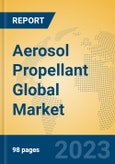Regional Market Trends
The Aerosol Propellant market varies by region, influenced by industrial and consumer needs. Asia-Pacific, led by China and India, dominates due to manufacturing and personal care demand. China expects a CAGR of 5.0% to 7.0%, driven by production and consumption growth. India projects a CAGR of 4.5% to 6.5%, supported by personal care and industrial sectors.North America, mainly the United States, anticipates a CAGR of 4.0% to 6.0%, fueled by medical and industrial uses, with a focus on compliance. Europe, with Germany and France, expects a CAGR of 3.5% to 5.5%, emphasizing sustainable production. Emerging regions like Latin America and Southeast Asia project a CAGR of 4.0% to 6.0%, driven by industrial growth. Asia-Pacific leads in volume, while North America and Europe prioritize innovation.
Applications: Trends and Growth
Aerosol Propellants serve multiple applications, each with distinct growth and trends.- Personal and Household Care: This segment, including deodorants and hair sprays, projects a CAGR of 4.5% to 6.5%, driven by convenience, with trends toward eco-friendly propellants.
- Medical: Medical use in inhalers expects a CAGR of 4.0% to 5.5%, fueled by reliable delivery needs, with trends focusing on patient safety.
- Industrial: Industrial applications, like paints and foams, anticipate a CAGR of 4.5% to 6.0%, driven by infrastructure, with trends toward high-performance materials.
- Food: Food use in dyes and agents projects a CAGR of 4.0% to 5.5%, with trends emphasizing safe formulations.
Types: Trends and Growth
- Hydrocarbons: Hydrocarbons expect a CAGR of 4.0% to 5.5%, valued for cost-effectiveness, with trends reducing environmental impact.
- Dimethyl Ether (DME): DME projects a CAGR of 5.0% to 7.0%, favored for low emissions, with trends in eco-friendly products.
- HFCs: HFCs anticipate a CAGR of 3.5% to 5.0%, with trends toward phasing out for sustainability.
- HFOs: HFOs project a CAGR of 6.0% to 8.0%, driven by low environmental impact, with trends in premium formulations.
Key Market Players
Key players include Honeywell, Chemours, and Evonik Industries, leading in high-purity propellants. Diversified CPC, GTS SPA, Koura, Daikin, SRF, and Quanzhou Yuji New Material Technology contribute to industrial and electronic applications.Porter Five Forces Analysis
- Threat of New Entrants: The threat is low, with technical and regulatory barriers, though niche opportunities may attract entrants.
- Bargaining Power of Suppliers: Suppliers have moderate power, with raw material costs impacting pricing, mitigated by integrated firms.
- Bargaining Power of Buyers: Buyers hold moderate power, seeking quality, but propellants’ specialized role limits alternatives.
- Threat of Substitutes: The threat is moderate, with alternative systems available, but propellants’ efficiency reduces risks.
- Industry Rivalry: Rivalry is moderate, focused on quality and capacity, with limited players maintaining stability.
Opportunities and Challenges
Opportunities:
Growth in personal care, medical, and industrial sectors offers potential, enhanced by sustainability trends favoring eco-friendly propellants.Challenges:
Raw material volatility and regulatory pressures pose risks, while competition from substitutes requires innovation.This product will be delivered within 1-3 business days.
Table of Contents
Companies Mentioned
- Honeywell
- Chemours
- Evonik Industries
- Diversified CPC
- GTS SPA
- Koura
- Daikin
- SRF
- Quanzhou Yuji New Material Technology








